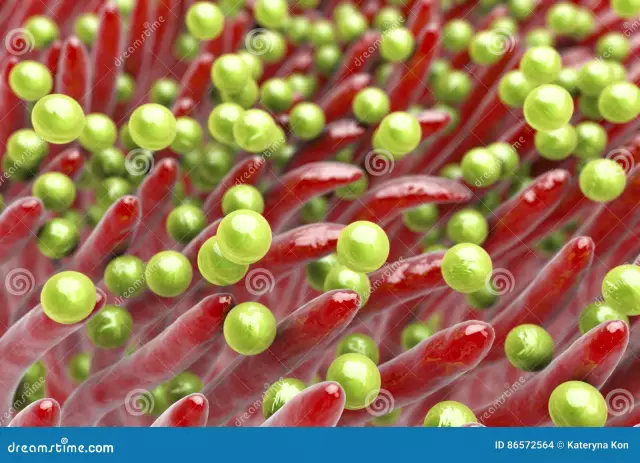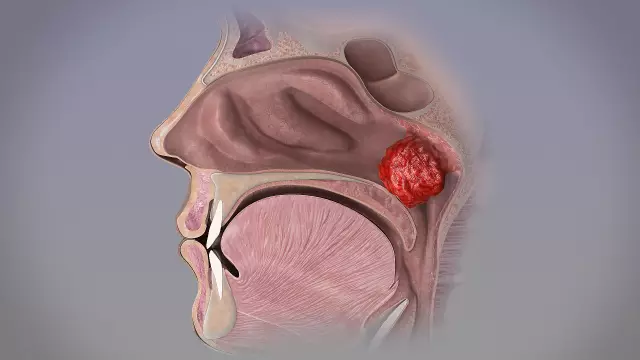- Author Rachel Wainwright [email protected].
- Public 2023-12-15 07:39.
- Last modified 2025-11-02 20:14.
Runny nose
Rhinitis (runny nose) is an inflammatory process that occurs in the nasal mucosa. Viruses can cause a runny nose. Viruses enter the nasal mucosa along with the inhaled air. They disrupt the functioning of cells and create all conditions for the addition of a bacterial infection. Rhinitis can develop with general hypothermia. Sometimes a runny nose appears under the influence of occupational hazards (dust, smoke, strong smelling harmful substances). Other causes of the disease can be manipulation of the nasal area or trauma to the nasal mucosa by foreign bodies.
Stages and types of rhinitis
Changes in the nasal mucosa go through three main stages. The reflex stage of the common cold develops when the body is hypothermic. The reflex stage of the disease is accompanied by narrowing and subsequent expansion of the blood vessels, as well as edema of the turbinates. At this stage of the disease, there is a burning sensation in the nasal cavity, dryness, difficulty breathing and repeated sneezing.
The catarrhal stage of the common cold usually lasts two to three days. This stage develops under the influence of viruses. The catarrhal stage of the common cold is characterized by the appearance of abundant transparent watery discharge from the nose, the appearance of lacrimation, congestion of the ears and a nasal tone of voice. At this stage of the disease, nasal breathing and olfactory function decrease.
The beginning of the final stage is accompanied by the onset of bacterial inflammation. At this stage of rhinitis, the sense of smell and nasal breathing are gradually restored, the general condition of the body improves, but the discharge from the nasal cavity becomes green or yellow.
The entire cycle of a common cold usually lasts seven to ten days. With timely treatment, recovery can occur within two to three days. With insufficient treatment and weakened immunity, a runny nose can become chronic.
By the nature of its origin, a runny nose can be allergic, vasomotor, medication, infectious, traumatic, meteotropic, atrophic or hypertrophic.
Allergic rhinitis develops under the influence of any allergen. The role of the allergen can be played by plant pollen, animal hair, fluff, food products. Allergic rhinitis is usually accompanied by tingling in the nose, itching, burning, sneezing, difficulty breathing, and profuse watery discharge. The inflammatory process with an allergic rhinitis from the upper respiratory tract can move to the lower parts. That is why timely diagnosis and treatment of allergic rhinitis is very important.
With vasomotor rhinitis, the blood vessels dilate. This type of rhinitis usually appears as a result of hormonal disorders, emotional experiences. Vasomotor rhinitis can also develop under the influence of tobacco smoke, exhaust gases, spicy and hot food. The manifestations of a runny nose can be accompanied by tearing, sneezing, insomnia, headache, profuse mucous discharge. Medication rhinitis develops with prolonged use of vasoconstrictor drugs.
Infectious rhinitis is viral, mycotic, bacterial. Usually this type of rhinitis accompanies other diseases (influenza, SARS, diphtheria, gonorrhea, scarlet fever).
Atrophic rhinitis develops with thinning of the bone skeleton or the nasal mucosa. It is accompanied by dryness in the nose, burning sensation, and decreased sense of smell.
Hypertrophic rhinitis is characterized by tissue proliferation (mucous membrane and submucosa.
There are acute and chronic rhinitis. Acute rhinitis is characterized by a sudden onset. Weakness, headache, decreased performance appear. This type of rhinitis is accompanied by profuse nasal discharge, first liquid and transparent, and then thicker, yellow-green in color. The mucous membrane of the nose swells, breathing becomes difficult, the sense of smell disappears, the perception of taste decreases.
Chronic rhinitis develops with prolonged or often recurring rhinitis, with prolonged exposure to the nasal mucosa of various irritants (dust, harmful vapors and odors). The reason for the appearance of a chronic rhinitis can be irritation of the nasal mucosa with purulent discharge in diseases of the paranasal sinuses, prolonged circulatory disorders in the nasal mucosa in diseases of the heart, kidneys, lungs, hormonal system.
Treatment of the common cold should be started when the first symptoms of the disease appear. For the treatment of rhinitis, you can use moisturizing, vasoconstrictor, herbal preparations, homeopathic and antiviral drugs, antibacterial agents, bacterial vaccines.
Runny nose during pregnancy

A runny nose during pregnancy can appear with the growth of nasopharyngeal polyps or adenoids. The cause of a runny nose during pregnancy can be an increase in estrogen and progesterone in the blood. Low levels of air humidity, various allergic reactions, an increase in the concentration of hormones in the blood lead to vascular changes that cause rhinitis.
In the early stages of pregnancy, rhinitis is dangerous. If the nature of the occurrence of a cold is viral, then there is a high probability that the virus will be able to penetrate the blood into the uterine cavity and cause spontaneous abortion.
In some cases, the cause of rhinitis can affect the formation of the embryo in early pregnancy. A runny nose during pregnancy at home can be treated with proven folk remedies.
Folk remedies for the common cold
In the complex treatment of a common cold, you can use various folk remedies. For rhinitis, put three to five drops of menthol oil into each nostril. The procedure should be repeated twice a day. Additionally, oil can be applied to the wings of the nose, temples, forehead. Kalanchoe juice is an effective folk remedy for the common cold. In the initial stage of rhinitis, three to five drops of Kalanchoe juice should be instilled into each nostril. For the treatment of a cold, you can prepare a tincture. For this, olive and sunflower oil (one hundred grams each) must be mixed with a tablespoon of chopped wild rosemary. The mixture should be infused for three weeks in a dark place, shaking daily. Strain, squeeze out. On the first day of treatment, instill two to three drops in each nostril, on subsequent days - one drop up to four times a day. The course of treatment should last no longer than a week.
An effective folk remedy for the common cold is red beet juice. During a runny nose, five to six drops of freshly squeezed red beet juice can be instilled into each nostril. You can soak a cotton swab in beet juice and place it in your nose. For chronic rhinitis, it is very useful to chew honeycomb and lubricate the nostrils with honey.
Inhalation with onion vapor will help with rhinitis. Chop the fresh onion and, stirring the onion mixture, inhale the onion vapors until they are completely depleted. This procedure must be repeated twice a day.
YouTube video related to the article:
The information is generalized and provided for informational purposes only. At the first sign of illness, see your doctor. Self-medication is hazardous to health!






